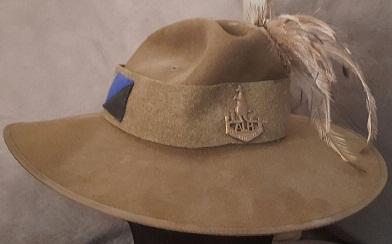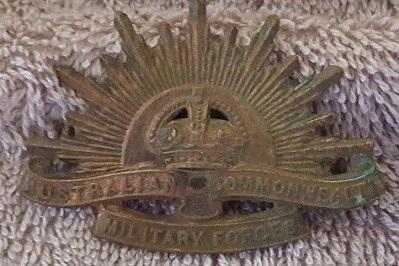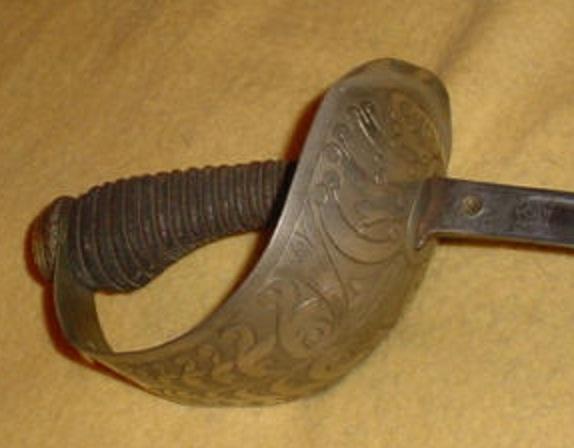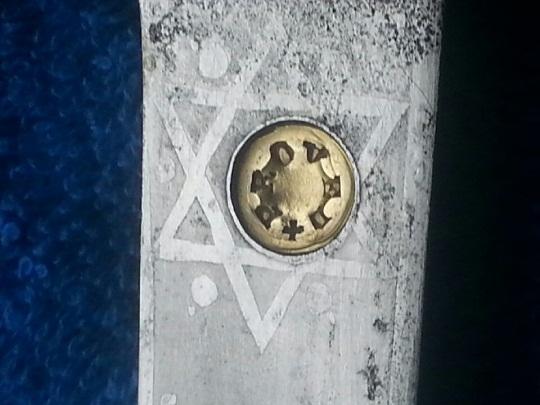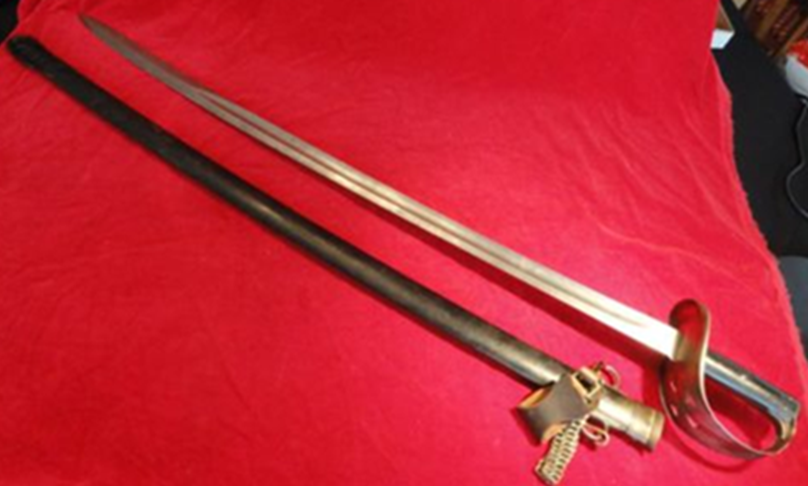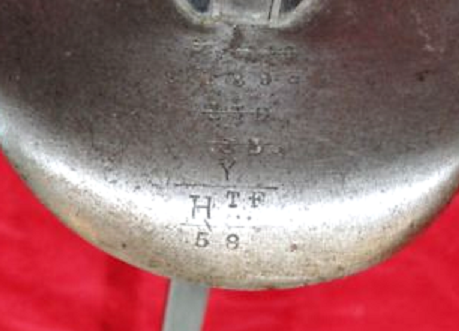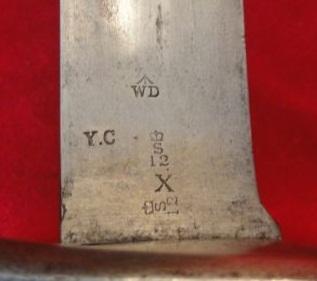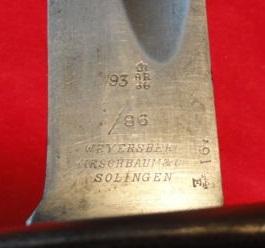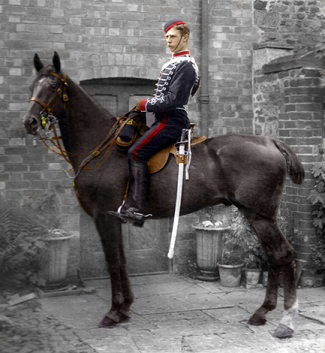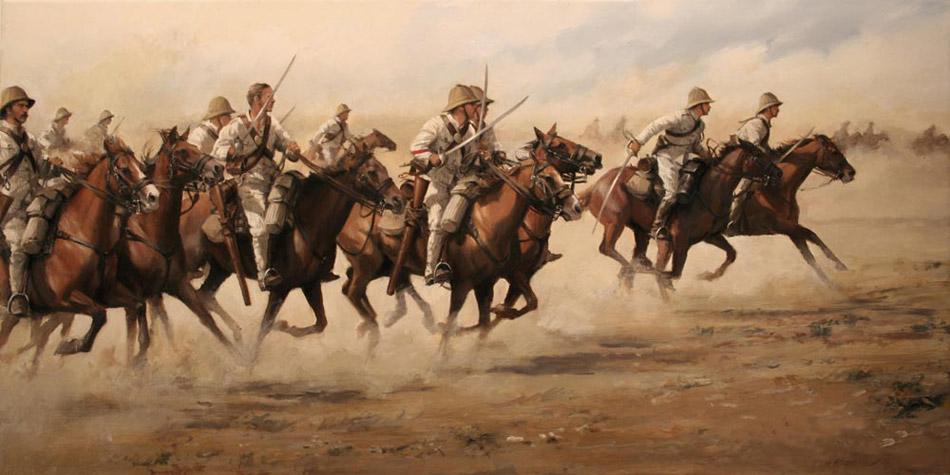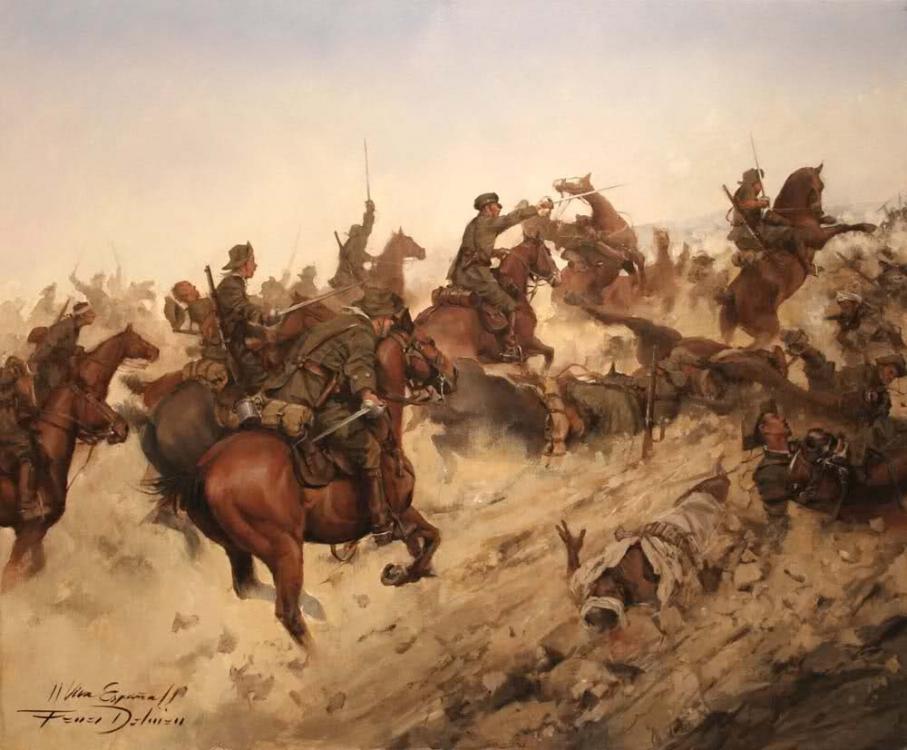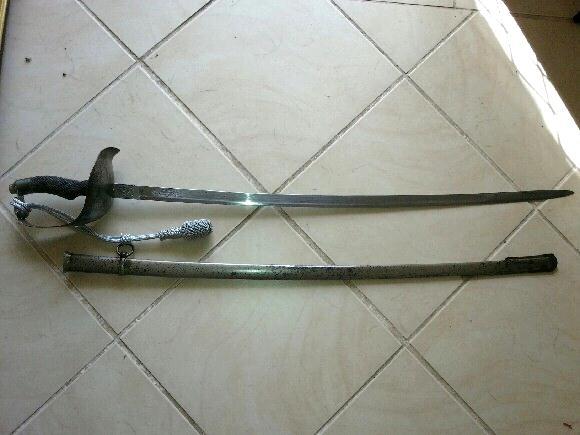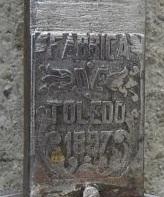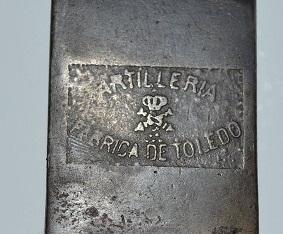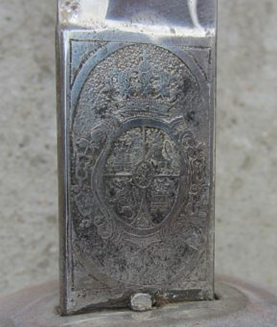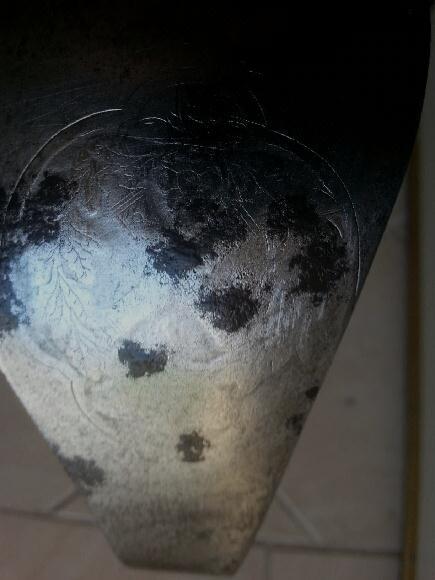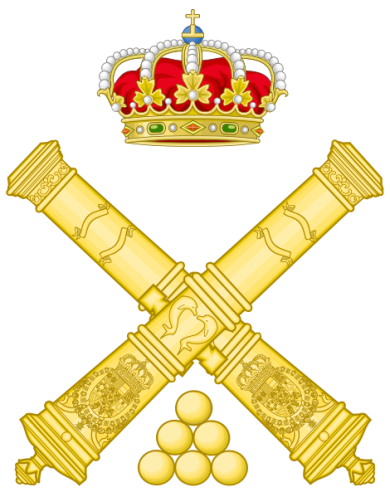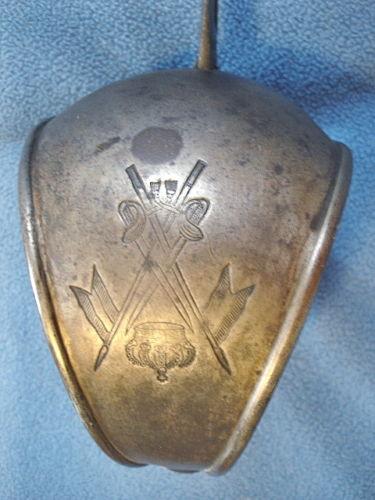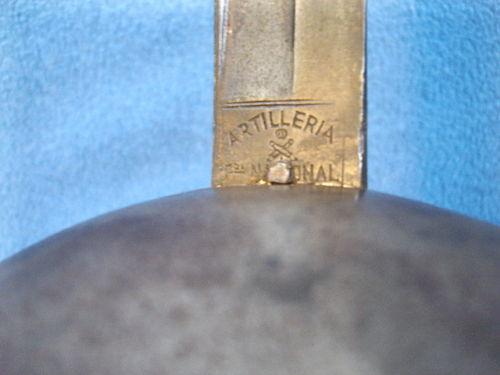-
Posts
563 -
Joined
-
Last visited
Content Type
Profiles
Forums
Blogs
Gallery
Events
Store
Everything posted by aussiesoldier
-
David and Brian, Thought I might add to this. I am lucky enough to know the wartime story of my Shun Gunto as dad brought it home from Buna/Gona in 1942 having taken off a Japanese 'Officer' who no longer had a need for. I had to replace the leather cover as all that was left after years of neglect was the lace section at the top. It never had a locking mechanism and was held in its wooden scabbard by pressure. There are no makers marks beyond a red painted symbol for Tokyo Arsenal. I had some assistance in tracing it and according to someone who knew it was probably machine made in the late 1930s before being fitted out for jungle service and a trip to New Guinea. It came without a tassel and I fitted a Company Officer's copy. Dad has passed, I got the service medals and the sword and now have a fight on my hands as to who I pass it on to! George
-
Dear GMIC members, Maybe an answer to my challenge from across the Channel. I registered on the Feldgrau site and one possibility arose. Corporal Wilhelm Bonig was from the small rural town of Dohnsen, in the district of Holzminden, to the south of Hannover He was listed as wounded in the 7 December, 1917 casualty list. Rural towns would have provided the horsemen necessary for a cavalry regiment and it is at least a logical solution. Considering the destruction of Prussian military records in April, 1945 air raids, I suspect this is almost as good as it is going to get. Putting even a small story to a named sword is always a moment of great joy. Thanx George
-
I have recently had some success chasing down a soldier's details from a very meagre beginning and I have a a faint hope that the site might be able to help me again. I have a; Kavallerie-Degen M.1889, 2 Hannover Dragoon Regt Nr16, Lüneburg; a "Eigentuems Stuecken" or "Owned Pieces" with the o wner’s name engraved on bottom of guard = GEFR BONIG. The regiment's story is The 16th (2nd Hannover) Dragoons : On mobilization, the 16th Dragoons, was raised to a strength of 6 squadrons before being split into two half-regiments of 3 squadrons each. The half-regiments were assigned as divisional cavalry to 17th and 18th Divisions. On mobilisation, IX Corps was assigned to the 1st Army on the right wing of the forces for the Schlieffen Plan offensive in August 1914 on the Western Front. It participated in the Battle of Mons and the First Battle of the Marne which marked the end of the German advances in 1914. Later it saw action in the Battle of Pozières and Battle of Amiens (1918). It was still in existence at the end of the war. And that is the MISSION IMPOSSIBLE. I would be very grateful for any assistance anyone can offer. George
-
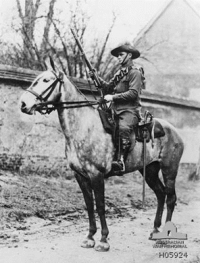
British P1912 Cavalry Officer's Sword
aussiesoldier replied to aussiesoldier's topic in Swords & Edged Weapons
I have, with the help of an number of websites, discovered the story of my sword's original owner. F L JOHNSTON, SCOTTISH HORSE. He was born 31/1/95. In the ranks of the Territorials to 11/3/15 when on the 12th March 1915, he is commissioned as 2nd Lieutenant Frederick Low Johnston, Scottish Horse and transferred to the 1st Battalion, The Royal Scots (The Royal Regiment). and served with the regiment in Egypt in 1916 to 11 November, 1918. He was promoted Lt. in September, 1917 and as Acting Captain on 1 November, 1918. Transferred to the Russian Front (Russian Civil War) in December, 1918. He served with the 1st Battalion, The Royal Scots at Secundrabad, in India in the early 1920’s. He is promoted substantive Captain in 1926, Major in November, 1937, and Acting Lt. Colonel in September, 1939. Serves with the Regiments Territorial battalions between 1932 and 1936, before returning to The Royal Scots in Palestine 1936-39. The 1st Battalion was deployed to serve in the 1936–39 Arab revolt in Palestine, where it would remain for a year, until January 1939, when it became part of the 4th Infantry Brigade, 2nd Infantry Division.From the London Gazette, 25th April 1939: Mentioned in Dispatches: The names of the under-mentioned have been brought to notice by the General Officer Commanding the British Forces in Palestine and Trans-Jordan in recognition of distinguished services rendered in connection with the operations in Palestine during the period 1st April to 31st October, 1938:- 1st Battalion, The Royal Scots (The Royal Regiment). Johnston, Maj. F. L. He is awarded the Order of the British Empire in 1939 (Yorkshire Post 8th June 1939) probably in recognition for this service. He promoted Acting Lt. Col. In September 1939 and Brigadier in 1942. I n 1952 is awarded an Ordinary Commander of the Civil Division of the said Most Excellent Order, CBE, possibly because of his service with the Territorial and Auxiliary Forces Associations, Edinburgh City, The Lothians and Peebles. He died in 1971. The web has its advantages and I am delighted that I could bring this story to life. -
Trooper D, Happy to comply. My last slouch, not worn a great deal because I became a Cadet Corps Officer - turned to the dark side. The slouch fills out a little and sits higher on the head. Never got pulled up for it as long as it sloped to the front and side. I always kept a standard slouch for formal parades so that it sat more distinctly upon the head and stayed there in heavier winds. It is badged and displayed as a 12 ALH regiment slouch with original style pugaree in honour of the 12th Australian Light Horse Regiment (4th Brigade)and its charge at Beer Sheva. I work at a Jewish College and my late 2017 focus for commemoration is that charge. Hope this helps, George
-
G'day, Museum quality hats always lack the authenticity of the soldier's ability to flatten the bash to suit his own likes - within the dress regs. I always pulled the front and back of mine down and squared off the ends as that was how we were told to 'change' it by our recruit instructor to suit the fashion of his battalion. It also displays the changed pugaree with the folded edges that was gradually used to replace the flat felt one used at the beginning of the war. I have not really been able to chart the changes but older versions have less folds than the more modern. More importantly, the image seems to be showing a modern cast replica badge with press studs. The badge I was originally issued had two slip pins (?) which we lost and replaced with match sticks. Interestingly enough when the AIF landed at Gallipoli all of its badges were blackened to hide the identity of the unit and to reduce shine. By 1917 AIF units on the Western Front had unblackened bronze because they wanted the Germans to know that it was Aussies on the other side - apparently it did help create a sense of fear amongst the Germans. Find attached a Somme Battle relic bought by my son for my 60th.
-
I actually don't know. I have not got that organised yet. Teaching in NSW is a full time job that I fit around seeing my family in the distant parts of the east coast of Australia.
-
To give you some idea - Sword on offer through eBay at US$400 + US$67.55 post = AUS$541 + AUS$91.46. This is simply prohibitive. I have only seen replicas on sale in Australia OR originals were on sale at a time I did not have the interest or money.
-
It is extremely expensive to purchase and transport a Patton to Australia and VERY few are ever offered for export. Whilst interested, it is not top of my list to purchase.
-
An original First World War British & Commonwealth Pattern 1912 Cavalry Officers Sword supplied and engraved with the officer’s name and regiment; F L JOHNSTON, SCOTTISH HORSE. The Sword, Cavalry Officer, Pattern 1912, as it was officially called, was the officer’s version of the Sword, Cavalry, Pattern 1908, and was the last service sword authorised for use by British and Commonwealth mounted officers. As Brian Robson in his excellent reference work Swords of the British Army writes: “Broadly speaking, the Pattern 1912 officer’s sword was a more ornamental version of the Pattern 1908 trooper’s sword, he states that it was “virtually identical with that of Pattern 1908 except for decoration and shape of the shoulder”. Individual swords and scabbards vary in weight because there was no rigidly enforced specification. Like the Pattern 1908, the Pattern 1912 was designed for function not form and caused uproar in certain quarters as a consequence of its utilitarian and practical appearance. King Edward VII described the trooper’s sword as "hideous" when the pattern was submitted to him for formal approval, and had to be persuaded of its practical utility before eventually conceding the point. The grip, designed by Colonel Fox was revolutionary in that when it was held it automatically brought the sword into the thrust position. This was important as the Pattern 1908 and 1912 had very limited cutting effect and were optimized for thrusting in line with the common wisdom of the time, which stated that “the point will always beat the edge”. This is a good example of a Pattern 1912 Cavalry Officers Sword. Steel hilt, stepped crosshatched brass pommel and steel ferrule. Grips: Sharkskin covered (much of it missing) wood bound with wire and a large depression for the thumb, grip length 165mm (6.5 inches). Guard: sheet steel bowl decorated with a scroll pattern and a sword knot slot near the pommel. The etched blade is straight tapered with a single fuller on each side to within 228mm (9 inches) of the spear point, double edged for the last 153mm (6 inches). Some damage caused by wrapping and rust to the top half of the blade. The ricasso is marked with the Damascene star and Proved cartouche. The back edge of the blade is etched with the London Made mark and the sword owner’s name and regiment. The blade etching is clear with the usual scrollwork and the Royal Cypher of HM King George V (GvR - Georgius Rex V - 1911-1936). Blade shows NO evidence of sharpening. The guard is superb with an aged patina. The hilt and pommel are tight, matched and secure. Overall Length: 1095.0 mm Blade Length: 895.0 mm Blade Width (at guard): 25.0 mm Scabbard Length: 925.0 mm Proof disc used by these retailers and therefore ONE of them supplied the sword; · JH Batson, Outfitter, 94 High St. Erith, London, · Lewis Moses Ltd New Oxford St London, and · Manton & Co Wilkinsons supplied some swords to Manton. Sadly, despite many efforts, I have not been able to identify F L Johnston of the Scottish Horse.
-
Paul, The market price varies enormously. I was lucky enough to pick this up with sword hanger attached for approx US$350 but I have seen them in worse shape for much more. Maybe you can be lucky. This one came with an edge and some evidence of sharpening but it is hard to tell when this occurred. I have other swords that were almost certainly used in WW1 that show deliberate grindstone sharpening (a KD89) and another that shows considerable wear at the front edges indicating sharpening in an previous life ( a RMLI 1897 sword). Over the next few days I will start to post these various swords with an educational component. It's what happens when a history teacher starts collecting swords!
-
Pattern 1885 Cavalry Troopers Sword. The guard is sheet steel with a part rolled edge and a pierced Maltese Cross design. The checkered black leather two piece grip is attached to the tang with five rivets and the back strap has the double arrow sale mark. The slightly curved blade has a single fuller to each side that ends 8.25 inches from the double edged point. The sword was made in 1886 and was issued to the 13th Hussars (D squadron, weapon #33) in Sept. of 1888, and retested by armourers before then passed on to the Hertfordshire Yeomanry (weapon 58) in August of 1893. The 'YC' = 'Yeomanry Cavalry'. 1885 Pattern Cavalry Sword After a false start in 1882, the 1885 pattern was developed following committee input on improving the sword. The first opposite ringed scabbard came out of this process along with a slightly shorter blade. This sword saw extensive use in the campaigns in Egypt and the Sudan during the 1880s and 1890s. The shortening of the blade did allow some opponents along the Nile to lie on the ground, putting themselves out of the reach of the trooper's sword! This problem was rectified in the 1899 pattern. Still this sword represented an important step in the evolution of British Cavalry swords and was used by the 21st Lancers at the Battle of Omdurman in 1898; amongst the daring lancers was a young Winston Churchill. Blade: 87.5 cm (34 1/2 inches) Overall: 106 cm (41 1/2 inches) The Hertfordshire Yeomanry as a fighting unit found its roots way back in the 1790's as a county based cavalry unit tasked with civil defence at a time of considerable unrest both at home and abroad. It underwent various changes throughout the 19th Century, including being disbanded and re-raised twice before earning its first battle honour in the Boer War of 1899 - 1902. The Hertfordshire Yeomanry, a volunteer force at the time of the Boer War supplied troops to the newly raised Imperial Yeomany who saw service in South Africa from 1900 onwards, taking part in many campaigns now synonymous with the conflict such as; LadySmith, Mafeking and Operations in the Orange Free State. The Yeomanry's involvement in The Great War came about through a shake-up in the United Kingdom's Territorial Forces in 1914. Upon the outbreak of war, many men serving in the Yeomanry (a home service unit) volunteered for 'Imperial Service' overseas, and as a result, the Herts Yeomanry, like many other Territorial Force units was split into two; the 1/1 and 2/1 Hertfordshire Yeomanry. Photo of a member of the Yeomanry equipped with either an 1885 or a very very similar, 1890.
-
The pattern 1796 Heavy Cavalry Sword was the sword used by the British heavy cavalry (Lifeguards, Royal Horse Guards, Dragoon Guards and Dragoons), and King's German Legion Dragoons, through most of the period of the Revolutionary and Napoleonic Wars. It played an especially notable role, in the hands of British cavalrymen, at the battles of Salamanca and Waterloo. The pattern was adopted by Sweden and was used by some Portuguese cavalry. John Le Marchant, who designed the curved 1796 pattern light cavalry sabre, initially intended that his own sword design should be adopted by all the cavalry; however, this was denied by the decision of the Board of General Officers to arm the heavy cavalry with a straight sword. Technically the 1796 heavy cavalry sword was a backsword, that is a sword with a straight blade with one cutting edge and the opposite edge of the blade (the "back") thickened for most of its length to give added strength. The blade was 35 inches (890 mm) in length, with a single broad fuller each side. The grip was of ribbed wood, or wood bound with cord to resemble the same, and covered in leather. The sword was often modified by its users. The point was originally a 'hatchet point', a curved diagonal front edge similar to that of the Japanese katana, but most were altered to a symmetrical 'spear point', more common at the time, or alternatively made more acute whilst retaining the asymmetry of the tip. This was done in order to improve the sword's ability to thrust. They are a beast of a sword made famous by the Sharpe series where he 'inherits' one from a dying fellow officer. Expensive to buy and not often offered for sale.
-
Robert Ballard did a dive on the Lusitania and reportedly filmed evidence of an IMPLOSION (torpedo) and a second EXPLOSION (?). [Admittedly difficult as she lies on the damaged sided, but he felt that he pieces he had filmed offered some firm evidence.] It is believed that as the liner was approaching harbour her coal bunkers were largely empty and full of coal dust. The program showed the explosive capacity of coal dust shacken and stirred (not James Bond's taste) and ignited to have explosive ability. The program concluded that the second explosion was real but caused by coal dust. Prior to this investigation it was thought that the ammunition or gun cotton the liner was carry (which did make it a legitimate target) was NOT capable of causing this explosion. They took photographs of coal spread all over the sea floor and the hole was where the bunker would have been. Not withstanding this, eye-witnesses all testified to the enquiry that they saw two torpedo tracks. As you wrote, Capt Goetz's report stated, he only fired one torpedo. The conspiracy is further advanced by the Admiralty ordering protective warships out of the area, and no record of the final submarine warning. Was Churchill that cynical. Yep!
-

The Museum to Visit....
aussiesoldier replied to Chris Boonzaier's topic in The Great War 1914 to 1918
Director Peter Jackson points out a multi-colored cannon used during the early days of the World War I at the museum exhibition he has created on Friday, April 17, 2015, in Wellington, New Zealand. The artillery piece behind Jackson. Is it not a rail gun captured during the August-Sept, 1918 Offensive? -
Always taken as a coincidence although, from Churchill's point of view after the sinking, a helpful coincidence. I remember reading many years ago (my brain hurts!) that the US ambassador to Great Britain attended a garden party days before the event, what would the USA's response be if a liner with many US citizens on board was sunk by a German submarine. Those who believe in conspiracy believe this was setting up the event. It is just as easy to see it as a logical question considering the circumstances. Not so easy to explain is the many eye-witnesses to the torpedo attack that testify to two tracks - even those who were not in a position to see testify thus. Truth is the first casualty of was.
-

Private Purchase Spanish M1895 Cavalry Sabre
aussiesoldier replied to aussiesoldier's topic in Spain
The most memorable action of the Spanish cavalry equipped with 1895 cavalry swords is best remembered for the three charges that the 4th Squadron of 21st Regiment of Cazadores, called "Of Alfonso XII", had made on September 20th 1909 in Taxdirt, place in the Rif, near Melilla, after the Spanish defeat of the Barranco del Lobo, during the war with Morocco. That day, an infantry brigade which did not participate in the main action was harassed by 1500 "Moors" of the Kabyle of Beni Sychar. One of the battalions of the brigade, namely "Catalonia", began to retreat under heavy harassment from the Rif, putting him in a difficult situation. General Tovar commanding the force, chose to send, to help the Spanish battalion, the only force available: a Squadron Cavalry from the Regiment "Alfonso XII". In front of the 80 riders, stood, the assistant of General Tovar, Lt. Col. José Cavalcanti, who sent three consecutive charges against the 1500 tribesmen, neglecting the numerical difference. The action of the Spanish cavalry, completely unexpected by the enemy, was a complete success because it allowed the withdrawal of the infantry and forced to yield the Rif entire line. The third charge involved only 20 riders, because the rest of the unit had fallen, dismantled or pursuing the enemy. Casualties of the "Alfonso XII" squad were 25 men and for the courage shown in battle, both Cavalcanti as the banner of the Regiment received the Laureate Cross of San Fernando, the Spanish highest military decoration. -
Regarding Spanish cavalry, the last massive charge was held in July 23rd, 1921, when the 10th Alcantara Regiment (Cazadores a caballo) was ordered to cover a disastrous retreat of demoralized Spanish infantry, some in ambulances, near Mount Arruit in Morocco, in a narrow valley while crossing the Igan River. The 10th were outnumbered by the Kabilian Moors' forces, light infantry but relatively well armed, including some machine gun sections, making good use of their well-known field for cover. Continuous charges cleared one after another of the commanding heights . Of the 226 men who had started the third day started the day, only 46 survived till sunset. These repeated charges with sword in hand led to the ultimate destruction of the Regiment; of some 461 men, only 80 managed to survive these fifteen days of hard fighting this withdrawal. However, their mission of the day was accomplished and the Spanish retreating forces reached their destination. The sword involved was mainly the M1907 Puerto-Seguro.
-
Spanish Sabre, Toledo Spain, Pattern 1895, dated 1897 by Fabrica de Toledo, Spain. This sabre is an original Spanish-American War era Spanish production Modelo 1895. It was made as a private and unauthorised order by an officer with the initials, CB, which he had engraved on the blade. Accordingly, it is not etched with the standard issue Artilleria Fabrica De Toledo arsenal mark, nor a serial number. He served in the artillery and has had the guard engraved with crossed cannon. It is an early, dated Third Cuban War of Independence era (1895-98) production Model 1895 sword and these are very scarce in any condition. Being a cavalry model for an artillery officer, it is even rarer. Most M1895's available on the market nowadays, being the post-war, undated specimens with the plain Fabrica de Toledo roll mark. The Model 1895 was the cavalry sabre issued to Spanish cavalry units during the Spanish-American war, and was very popular with officers as a dress sword but was widely modified on battlefronts as it was found to be too light for combat. It was replaced by a much more substantial cavalry sword, the Modelo 1907, which became one of the inspirations for the U.S. Patton Calvary Sabre. The Modelo 1895 represents a transitional period in cavalry sword design where the curved slashing swords of the Napoleonic period moved towards a straight lance like blade. Its grip, shaped to the human hand was a unique innovation for its time. The Modelo 1895 retains a slight curve while it has been lengthened from previous models. The blade is not flat, it has some hollowing, but no fuller. This sabre is stamped 1897, but follows the 1885 pattern.This sabre and scabbard measure 37 3/4 inches in length, the blade length is 30 1/2 inches. The guard is approximately 3 1/2 wide. Fabrica de Toledo = Made in Toledo (Spain), evidence of private order rather than the government issue Artilleria arsenal mark, and the coat of arms of Spain ( the three-towered castle for the Kingdom of Castile). The guard is decorated with crossed cannon of the Artillery Corp within a floral border, similar in design to the centre illustration. These were unauthorised private orders and purchases but not uncommon. The bladed is etched with the initials of the officer who ordered the sword (CB) as a private purchase.
-
A wonderful cavalry sword and one of my favourite possessions. By the early 20th century, it was recognized that cavalry sabres were more effective as thrusting weapons rather than cutting weapons, and the cavalry sabre designs of all the major powers reflected this. The M1907 Puerto-Seguro sword (named after his designer Captain Luis de Carvajal, Marquis of Puerto-Seguro) was the last combat sword issued to the Spanish cavalry. Originally designed in 1907 it did not enter production until 1918. It served not only in the North of Africa, but also in the Spanish Civil War (1936-39). There are action reports that show it was put into use in some charges and pursuits, to great effect. As late as 1930, Spanish cavalry regulations put every stress in getting as close as possible to the enemy to engage a sword fighting. The Spanish M-1907 cavalry sabre was widely used in the 1920s Morocco campaign, and by both sides in the Spanish Civil War. It features the classic Spanish chequered hardwood handle secured by two metal rivets, sports the familiar large, sweeping "basket" hilt, and boasts a long blade with a wide fuller for almost its entire length. The sabre carries legible serial numbers (19954) marked at the ricasso, and is stamped "ARTILLERIA / NACIONAL" at the reverse ricasso, along with the faint, barely legible marking, "TOLEDO". The sword was made during the reign of Alfonso XIII, that is, at some moment between 1907 and 1931, and probably in the mid-1920’s. Some argue that this is the genesis sword of the British P1908 and the Patton sword but previous French swords displayed essentially the same design features, The tide had turned in favour of thrust over slash and would never go back.
-
Not sure who to ask about this. I am going down to the Australian War Memorial and I'll drop a note into the research section. If you ever get out to Australia, you must visit the War Memorial - it is the best presented, best equipped war museum I have ever seen. Can access it via internet. Well worth a day or two.
-
In my gallery I have a photo of the US 2nd Cavalry showing them sporting 'Patton' cavalry swords, with the caption "Second Dragoons distinguished themselves. In April 1918, a scant three weeks after leaving the United States, the Second Cavalry found itself landed in France in the Toul sector. After being initially deployed to perform military police duties and to manage horse remount depots, the Regiment was the only American unit used as horse cavalry during the war. A provisional squadron formed by Troops B, D, F, and H was the last element of the Regiment ever to engage the enemy as mounted horse cavalry. The final Allied offensive, the Meuse-Argonne campaign lasted from 26 September to 11 November 1918. The Second Cavalry was attached to the American 35th Division, playing an important role as the left flank element of eight divisions and later as the main effort between the Meuse River and the Argonne Forest. The men from the Regiment were commended for "...accomplishing their tasks with fearlessness, courage, and disregard for danger and hardship."
-
There is a very ordinary ebook called "Lancers Charge" that has much of the organisational information on the German cavalry prior to the war. I searched extensively for wartime info and very little beyond 1914 is available. The Eastern Front was an area of considerable activity for German cavalry yet even on the net there is almost no coverage. 1918 is all about the British use of cavalry. Some of the best info I got was from internet copies of the US Army Cavalry magazine from the 1920's. The real gem there was an article that covered the poor support given to cavalry regiments = no continous supply of remounts, no meaningful supply of fodder, few opportunities to rest horses. The author was not suprised that German cavalry performed so badly considering. Indeed, the absence of experienced cavalry officers on the General Staff (where would they have gotten experience - at least the British had the experience of the Boar War) seems to have led to this poor state of affairs. I have not read any reference to this in any other source. Almost everything is British cavalry - even the French don't get much of a mention. I have tried to cover some of these points in my gallery!
-
I understand your forward planning. I have planned to take long service leave to be at Villers-Bretonneux in 2018. On 24 April, the Germans captured Villers-Bretonneux- which just a few weeks earlier the Australians had fought so hard to defend. The town's defence had been given over to British troops while the Australian divisions regrouped. The enemy attack was spearheaded by tanks which pushed through the British defences. This battle was unique in that it was the first involving tank-against-tank fighting, demonstrating the significance that tanks had increasingly come to assume in 1918. Orders for the immediate recapture of Villers-Bretonneux were met with a plan to launch an attack by two brigades, the 13th and the 15th. The unconventional night attack began on the 24th. One brigade approached from the north and one from the south, meeting at the village's eastern edge, thereby surrounding the Germans and driving them from Villers-Bretonneux and the adjacent woods. After the Anzac Day counter-attack, British and French commanders lavished praise upon the Australian soldiers who took part, Brigadier-General George Grogan, a witness, later wrote that it was "perhaps the greatest individual feat of the war", for troops to attack at night, across unfamiliar ground with only short notice, and no artillery preparation. These factors had proved essential to the Australian success. Foch spoke of their "astonishing valiance [sic]..." and General Sir Henry Rawlinson attributed the safety of Amiens to the "...determination, tenacity and valour of the Australian Corps". How can any true Australian not want to visit this place on the 100th anniversary of the battle.






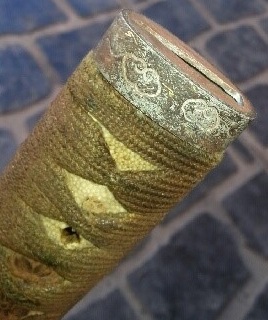
_Dragoons_1.thumb.jpg.8bc53d3c9a175fee12df372771d8b085.jpg)
_Dragoons_2.thumb.jpg.d09fabcf65594cd03307b7b5dadfaeb2.jpg)
